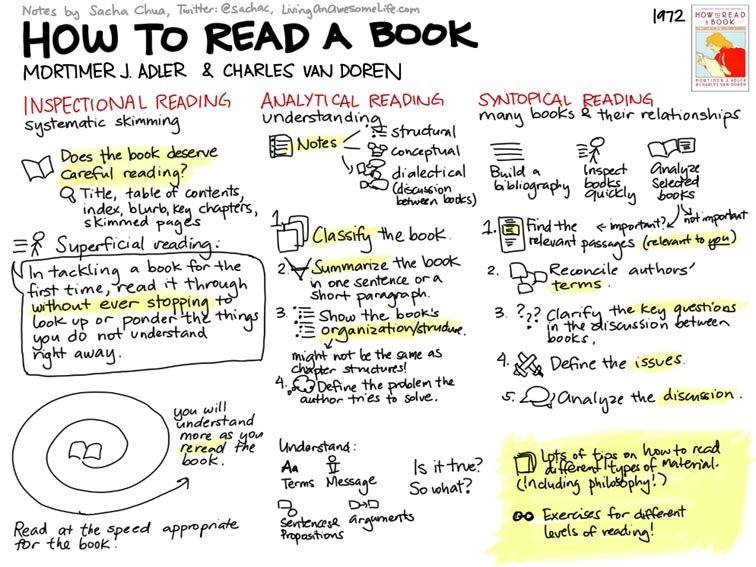How To Read A Book: 3 Strategies & Questions For Critical Reading
Critical reading includes ‘Inspectional Reading’: Reading with a focus on grasping the book as a ‘whole thing’–also called ‘Systematic skimming.’
 How To Read A Book: 3 Strategies For Critical Reading
How To Read A Book: 3 Strategies For Critical Reading
by Terry Heick
If you’re not familiar with Adler and Van Doren’s How To Read A Book, it is worth, well, reading.
As you might’ve guessed, these have less to do with decoding, and more to do with comprehension. Actually, more to do with the perspective you approach your reading with. It and How To Read And Why by Harold Bloom are two exceptional starting points for (as well as Wendell Berry’s short essay In Defense Of Literacy) fork coming to terms with the idea of critical reading–both the why and the how.
Which is where the following sketch note from livinganawesomelife.com comes in. We first shared this graphic on a post that showed examples of sketch notes (a note-taking form near and dear to my heart), but this one seemed worthy of its own post.
3 Strategies & Questions For Critical Reading
For most of us, reading strategies aren’t new, nor is reading through a critical lens. But offering specific, strategic mindsets students (and teachers) can use to approach and consume new texts with might be.
Inspectional Reading: Reading with a focus on grasping the book as a ‘whole thing’–what Adler & Doren call ‘Systematic skimming’
Example question: Why is this book important and/or worth reading? And further, how might our answer change before and during an initial reading, and then during a second reading?
Analytical Reading: Reading with a focus on close examination and analysis of the text in and of itself
Example question: How does the Thomas Merton use setting to establish and develop the theme of ‘Seven Story Mountain’? And how would our reading change if our reading was driven by that question?
Syntopical Reading: Reading with a focus on the relationships between texts
Example question: How can Jospeh Heller’s ‘Catch 22’ be seen as a kind of response to Erich Maria Remarque’s ‘All Quiet on the Western Front’? Or more specifically, if we assume it is a response, how might we read the former differently?
If you’ve read the book, you’ll notice that this is an oversimplification of the text, but for the purpose of this quick post, you get the idea.
Now go read the book. ; ^ )
Sidenote: The language and terms here don’t matter. Rename these if you need to so that students might find them more accessible. Academic vocabulary is a huge barrier for students. Reduce it when you can.
Image attribution livinganawesomelife.com; How To Read A Book: 3 Strategies For Critical Reading
